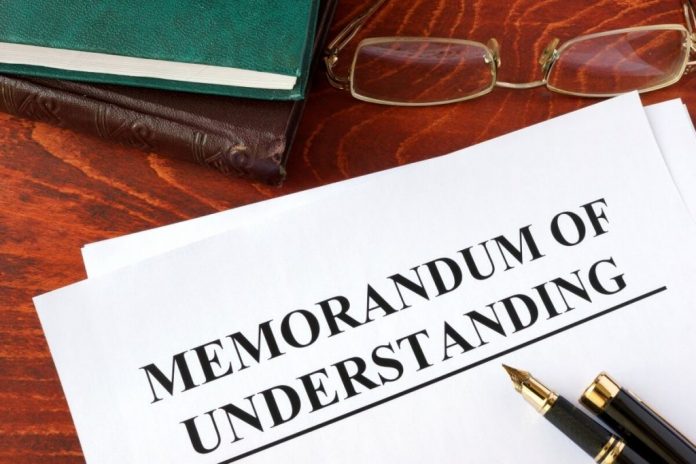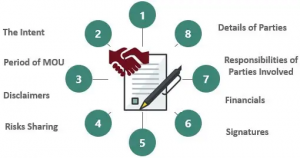This article is written by Amit Darshan, pursuing a Certificate Course in Introduction to Legal Drafting: Contracts, Petitions, Opinions & Articles from LawSikho.com.
Table of Contents
Introduction
A memorandum of understanding (MOU) is an agreement drafted as a formal document between two or more parties. MOU’s are generally not legally enforceable and the parties entering an MOU tend to avoid all sorts of legal consequences.
An MOU acts as a starting point for negotiations, thereby defining the scope and the purpose of the communication between the parties. In other words, it showcases the intention of the parties to enter into a legal agreement. MOU’s generally form as an initial phase in international treaty negotiations and could also be a part of a merger acquisition between two businesses as an example.
Purpose of a memorandum of understanding
One of the initial questions which might arise would be why two parties would put an effort in drafting an MOU, if it is not an enforceable document. One of the examples to understand when a party would be legally required to enter/create an MOU would be in the case of a housing authority when they would need to negotiate with their tenants.
The main purpose of entering an MOU is because it has a lot of potential power as it requires the parties to come to some sort of mutual agreement, and in order to do that, they have to take stock of their needs and wants and put them on paper. In such situations, an MOU is an appealing option because it’s simple and direct, without the complexities and combative standard terms and conditions of contract law. Parties can themselves mutually draft an MOU agreement without needing legal expertise.
An MOU would list the mutually accepted expectations of the parties once the initial negotiation is being done by them, on reaching a mutual consensus of each other’s expectations an MOU would be created. Parties would generally enter into an MOU, prior to entering into a legal agreement/contract as they usually would desire to avoid any legal consequences. Hence an MOU is preferred at the initial phase.
Steps involved in an MOU
- Planning,
- Drafting,
- Negotiating,
- Time Period,
- Restrictions.
Contents of an MOU
An MOU is a documented expression showcasing the intent of the parties. Hence, the purpose of MoU is not limited and can be adopted for any scenario in case the parties do not desire to enter a formal contract. Listed below are vital/crucial clauses that form an MOU:
- Proposal: A proposal would mean, one of the parties putting forward their intention of entering into an MOU, it mainly consists of important attributes such as listing purpose, obligations, and intention of the party to enter an MOU with the other one.
- Acceptance of the proposal: Acceptance of terms and conditions mentioned by the other party.
- The intention of legal binding: The parties may outline in the MoU that certain clauses are binding and enforceable in nature. Where an agreement is explicitly stated as MoU, it does not override the binding effect; it depends upon the intention of the parties and the drafting of clauses. The same was laid down by Supreme Court in Kollipara Sriramulu v. T. Aswathanarayana and Ors, that “a mere reference to a future formal contract will not prevent a binding bargain between the parties. The fact that the parties refer to the preparedness of an agreement by which the terms agreed upon are to be put in a more formal shape does not prevent the existence of a binding contract.”
- Consideration: The parties generally do not have considerations involved in MoU unless it has the binding effect of an agreement therefore, formal means of dispute resolution like arbitration should be avoided.
Crucial elements information of a memorandum Of understanding
- Date: MOU execution date
- Name the parties in the agreement: Parties entering the agreement. The names of the persons with authority to enter into the agreement, also as authorised persons delegated by the parties to sign the acceptance of the understanding.
- Description of a common objective for entering the MOU: The description would state the framework for the specifications of the MOU. Developing specific goals and objectives that provide the basis for evaluating the effectiveness of an MOU.
- The expertise of each party: This description would include the scope of responsibility or operational goals for each party.
- Description of the clientele: This is implemented only for MOU’s which involve services to or for referral clientele. One of the easiest ways to highlight this is to write in general terms at the beginning of the MOU. In this, eligibility requirements/determinations could also be included.
- Description of the communication process: Regular or timely meetings between agency directors or parties, case conferences between workers, paper flow, correspondence, reports, service orders, and/or the naming of persons involved in the communication process.
- Reporting/recordkeeping mechanism: This can be handled in general terms in the instrument itself, but the provider should be fully aware of any reporting /recordkeeping needs.
- Provide for confidentiality assurance: Confidentiality assurance can be viewed as an essential practice for the protection of clients’ rights when any information is gathered and shared between agencies, and therefore should be included in the MOU instrument.
- Description of publicity procedures: It is advisable to assure that publicity involving both parties be coordinated or cleared. One way to do this is to limit the use of agency names by the respective parties.
- Confidentiality: Data protection of the vital information being shared by the parties with each other in an MOU.
- Dispute resolution: As such MoU is not a standard contract, thus not enforceable unless the parties expressly state it. A formal dispute resolution clause is generally not found in an MoU, therefore parties either resort to mutual negotiations or refer to the higher authorities of the organization.
- Amendment: For example; the memorandum of understanding may be amended on the initiative of either party by submitting a proposed amendment in writing to the other party and agreement of that party to the amendment.
Advantages of an MOU
- A formal document laying out the roles and responsibilities of all the parties involved.
- Better than verbal commitments.
- Provide a good reference point in case of disputes.
- Lays out of the intent of all the parties towards a common goal.
- Convenient and easier to frame than a legally binding contract.
- Is friendlier and less threatening than a formal legally binding contract.
- Makes it possible to avoid obligations under international law when countries are signing the MOUs.
Disadvantages of MOU
- Can just be a broad statement.
- Does not deal with the practicalities of day-to-day working.
- If actions and timescales are not attached then won’t provide a framework for the achievement of outputs.
Conditions for alteration and termination
An MOU’s terms and conditions can be altered on the mutual agreement upon both parties. Parties can also agree upon a notice period by which a party can terminate the MOU by serving notice as per the provisions under the notice period.
Conclusion
MOUs are widely used and considered to be an important starting point in bilateral and business relationships. Formally written roles, responsibilities, and risks provide clarity on how different situations will be approached during the course of the agreement.
Some MOUs prove to be just as good as legal contracts, because parties stick to them at all times for the larger mutual benefit, while others flounder because parties do not adhere to them due to diminished viability (in which case it is mutually dissolved) or due to selfish interests of the parties involved.
References
- https://blog.ipleaders.in/mou-and-its-enforceability-in-india/
- https://people.howstuffworks.com/memorandum-of-understanding1.htm
- http://www.legalserviceindia.com/legal/article-709-the-legal-validity-of-mou-in-india.html
Students of LawSikho courses regularly produce writing assignments and work on practical exercises as a part of their coursework and develop themselves in real-life practical skills.
LawSikho has created a telegram group for exchanging legal knowledge, referrals, and various opportunities. You can click on this link and join:
 Serato DJ Crack 2025Serato DJ PRO Crack
Serato DJ Crack 2025Serato DJ PRO Crack











 Allow notifications
Allow notifications


